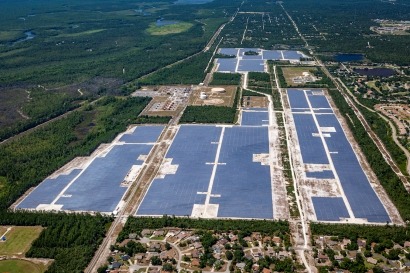
The plant will be the first in the nation and among the world’s first power plants to produce and use green hydrogen to power a gas turbine for peaking power applications, when the grid requires additional electrical generation to meet demand.
“Duke Energy is constantly evolving and seeking ways to provide clean, safe energy solutions to our customers,” said Melissa Seixas, Duke Energy Florida state president. “DeBary will be home to Duke Energy’s first green hydrogen production and storage system connected to existing solar for power generation, and we are grateful to the city for allowing this innovative technology in their community.”
This one-of-its-kind, end-to-end system will begin with the existing 74.5-megawatt (MW) DeBary solar plant providing clean energy for two 1-MW electrolyzer units that will separate water molecules into oxygen and hydrogen atoms.
The resulting oxygen will be released into the atmosphere, while the green hydrogen will be delivered to reinforced containers for safe storage. During times when energy demand is highest, the system will deliver the stored green hydrogen to a combustion turbine (CT) that will be upgraded using GE Vernova technology to run on a natural gas/hydrogen blend or up to 100% hydrogen. This will be the nation’s first CT in operation running on such a high percentage of hydrogen.
“This first-ever, commercial operation of a gas turbine on 100% hydrogen will be a groundbreaking achievement for Duke Energy and for our industry. Our existing solar field and gas turbines at DeBary provide a unique opportunity for us to produce green hydrogen, store it onsite and then combust it to ensure reliable service when electricity demand is high,” said Regis Repko, Duke Energy’s senior vice president of generation and transmission strategy.
“This combination of technologies will allow gas turbines to become decarbonized, dispatchable assets that support the addition of more renewables to our grid, and we appreciate the opportunity to collaborate on such an innovative project with GE Vernova and others.”
“Duke Energy anticipates hydrogen could play a major role in our clean energy future,” said Repko. "It is a clean energy also capable of long-duration storage, which would help Duke Energy ensure grid reliability as we continue adding more renewable energy sources to our system.”
Demand for energy in the United States and globally is increasing rapidly, making it even more challenging to rely solely on intermittent, renewable energy to keep the power grid operational when the wind is not blowing, or the sun is not shining. However, hydrogen produced from excess renewable energy during optimal generation conditions and stored for later use by gas turbines can provide a unique mechanism to help ensure reliable, affordable, and more sustainable electricity generation.
“GE Vernova is thrilled to work closely with Duke Energy on this project, which is a perfect example of the interplay opportunities between renewable energy and efficient gas-fired combustion technologies and exhibits how gas turbines are an essential technology in the energy transition,” said Eric Gray, President and CEO of GE Vernova’s Gas Power business.
“Multiple engineering and consulting teams located across GE’s sites worldwide will support the DeBary Hydrogen Project, perform any needed modifications to the gas turbine and work with Duke Energy to support the overall integration of the hydrogen fuels. We are honored to work with Duke Energy in this first-of-its-kind project.”
Readily available hydrogen is a dispatchable energy source, meaning it is available on demand. It can be turned on and off at any time and is not dependent on the time of day or the weather, like sun, wind or other renewable energy sources known as intermittent.
Dispatchable energy provides a needed element of reliability that will enable us to add more intermittent energy sources, yet still ensure we can meet customer demand, even during extended periods of high demand. Using solar energy to generate green hydrogen enables solar plants to be optimized. Relying on intermittent energy sources without available dispatchable energy sources would put our future electric system at risk of having insufficient energy to serve customer demand.
To support the project, GE began working with Duke Energy on a hydrogen plant readiness assessment in 2021. Following the installation of the electrolyzer equipment and hydrogen storage capacity on site, GE Vernova will execute modifications to the existing gas turbine infrastructure at the DeBary plant, including the fuel handling systems, valves and piping compatible with higher blends of hydrogen operation and up to 100% hydrogen (by volume). GE Vernova will also install the fuel skid with hydrogen blending, finalize control modifications, and support the overall integration of the project to support 100% hydrogen operation expected in 2024.
When fully operational, the converted 83 megawatt (MW) 7E gas turbine will have the ability to operate on natural gas, liquid fuel, 100% hydrogen, or a blend of natural gas and hydrogen providing the site with complete fuel and operating flexibility while maintaining plant reliability.
Located just north of Orlando, the Duke Energy Florida DeBary plant consists of a 74.5 MW solar power plant spread across an area covering the equivalent of almost 200 football fields and a 692 MW gas power plant for reliable reserve power. The power plant is powered by six of GE’s 7B gas turbines and four of GE’s 7E gas turbines.

